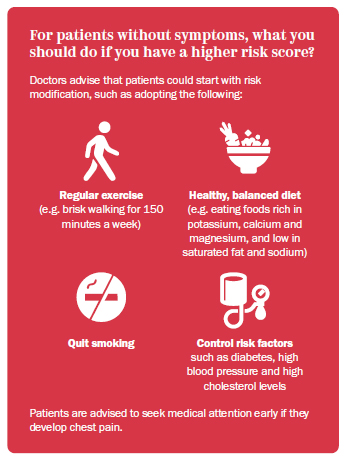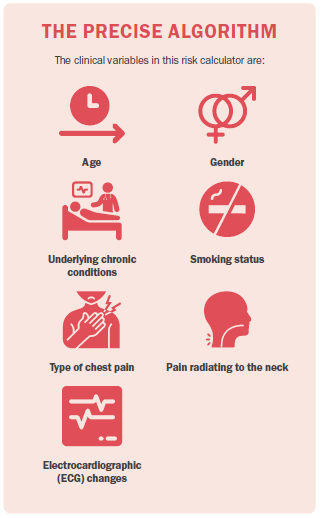What do you do when you have a chest pain?
What do you do when you have a chest pain? With the exception of emergency scenarios, often times one would first turn to his family doctor for help. In primary care setting, earlier studies1 have shown the usefulness of risk calculators in aiding physicians to assess patients' risk of heart disease.
SingHealth Polyclinics, in collaboration with NHCS and Duke-NUS Medical School, developed a diagnostic risk calculator - PRECISE (Predictive Risk scorE for CAD In Southeast Asians with chEst pain) which can be potentially used as a decision support tool at the primary care level to predict coronary artery disease (CAD) in patients presenting with stable chest pain (typically those exhibiting stable or atypical symptoms).
Understanding Cardiac Risk Scores
Cardiac risk calculators or scores are commonly used by physicians to assess a patient’s baseline cardiac risk, and predict the probability of having CAD or cardiac events based on certain key risk factors. Different cardiac risk calculators are used in different scenarios, for example, in patients without symptoms versus in those with chest pain. Taking into account the patients’ risk factors such as age, gender, smoking status, and underlying health conditions like blood pressure and cholesterol levels, the risk score generated shows an estimation of one’s risk of having CAD. Dr Chee Fang Yee, Associate Consultant, Department of Cardiology, shares that there are typically two types of common risk scores used in the clinical setting. “The Framingham Risk Score is applicable to patients without previous cardiac events, who are between the ages of 30 and 79 and non-diabetic. The other tool, CAD Consortium Score, is used to determine the probability of CAD in patients with stable chest pain prior to diagnostic investigations.”
The Framingham Risk Score can be used in asymptomatic patients to calculate their risk of heart attack or death in 10 years’ time. Patients can input their blood pressure and cholesterol figures into the calculator found online, to get a result instantly.
Dr Chee explained that the risk score is useful in the clinic setting where doctors can refer to the risk score to help patients better understand how certain risk factors impact their risk levels. “If the score reveals an increased risk in CAD, the doctor can discuss the next steps with the patient – such as risk factors modification and/ or starting a medication like statin or aspirin. For instance, we can show how the patient’s risk profile changes if smoking is taken off the equation – usually resulting in a substantial reduction in cardiac events.”

Developing a Diagnostic Risk Calculator More for Local Population
The Framingham Risk Score and CAD Consortium Score were developed largely for the Western population. “The tools currently available, though useful in assisting physicians in predicting the probability of CAD in patients with stable chest pain at the primary care setting, have not been validated for use in our local population,” said Assoc Prof Jonathan Yap, Consultant, Department of Cardiology.
To address this gap, SingHealth Polyclinics, together with NHCS and Duke-NUS Medical School, embarked on a study to recruit more than 1,600 patients with symptoms of stable chest pain from various SingHealth polyclinics, to develop a risk score for the local population. All patients were clinically stable and referred to NHCS for further cardiac evaluation. About 10% of patients were eventually diagnosed with CAD and the rest, assessed not to have CAD. For the
latter group, less than 1% developed major adverse cardiovascular events.

Using the key predictors of CAD in the study, the PRECISE diagnostic risk calculator was developed and compared against existing risk prediction tools2.
“PRECISE showed excellent ability to differentiate those with and without CAD. This tool will help primary physicians to better assess a patient’s risk for heart disease and in doing so, enable patients to receive appropriate and timely care at our specialist centre,” shared Assoc Prof Yap, who is also a co-author of the study. He added that this would potentially help to streamline referral processes for those who require more in-depth investigations.
Work is currently in progress to introduce the PRECISE risk score in SingHealth Polyclinics.
1 Goff DC Jr, Lloyd-Jones DM, Bennett G, et al. 2013 ACC/AHA guideline on the assessment of cardiovascular risk: a report of the American College of Cardiology/American Heart Association Task Force on Practice Guidelines. Circulation 2014; 129:S49.
2 The prediction tools used for comparison in the study are the Duke Clinical Score, CAD Consortium Score and Marburg Heart Score.
This article is from Murmurs Issue 40 (May – August 2021). Click here to read the full issue.
